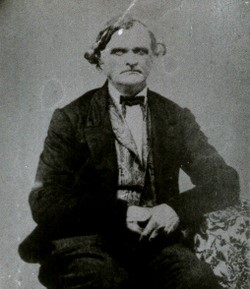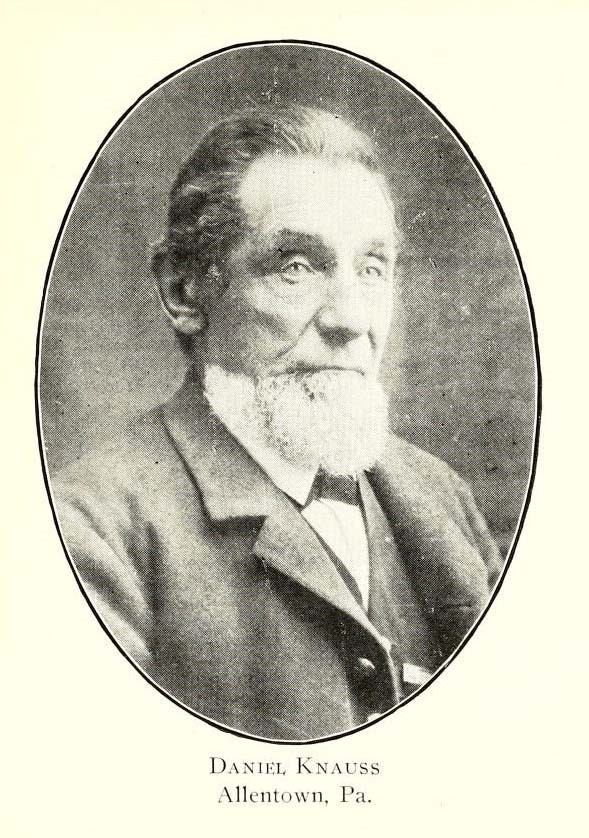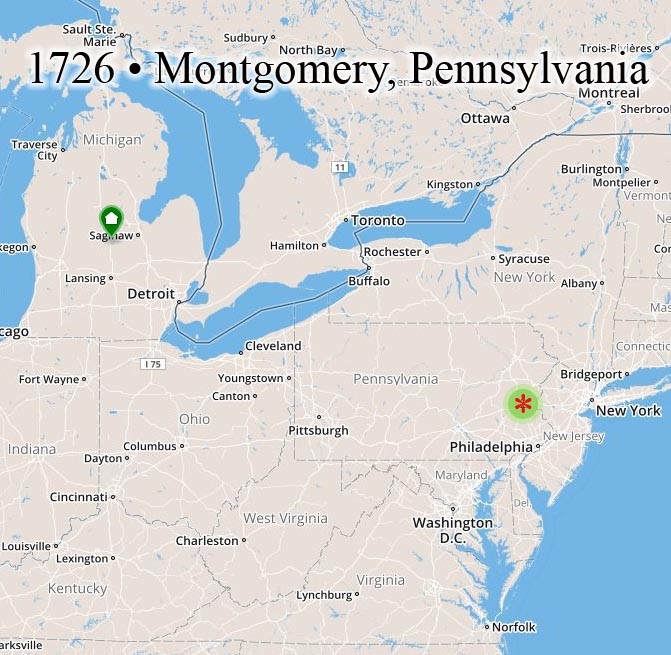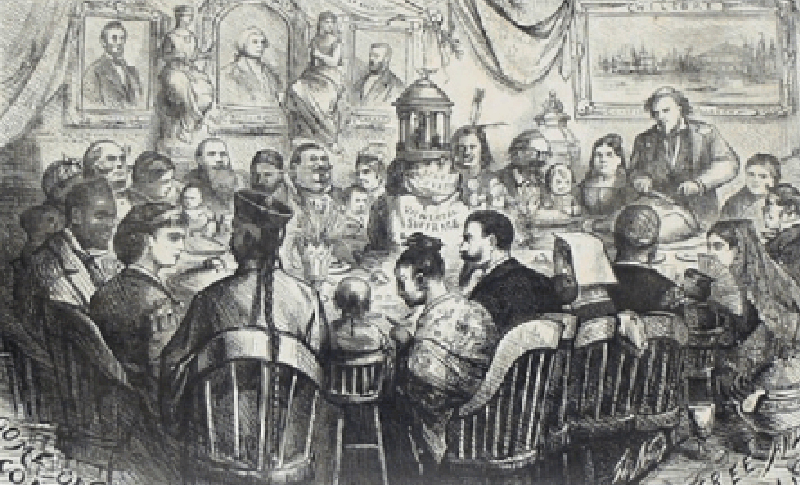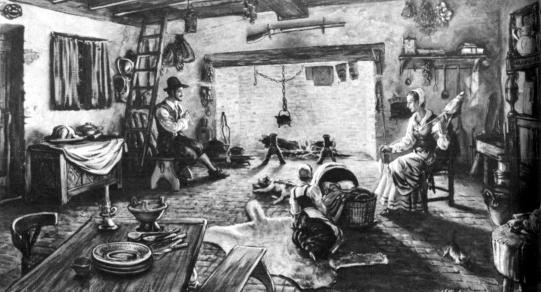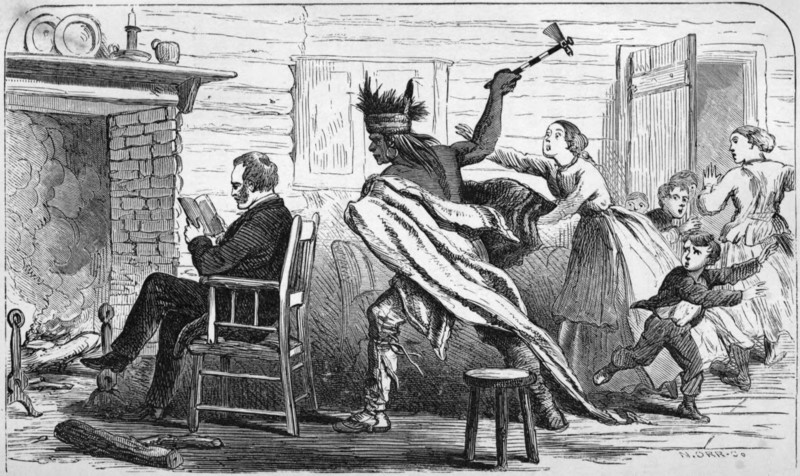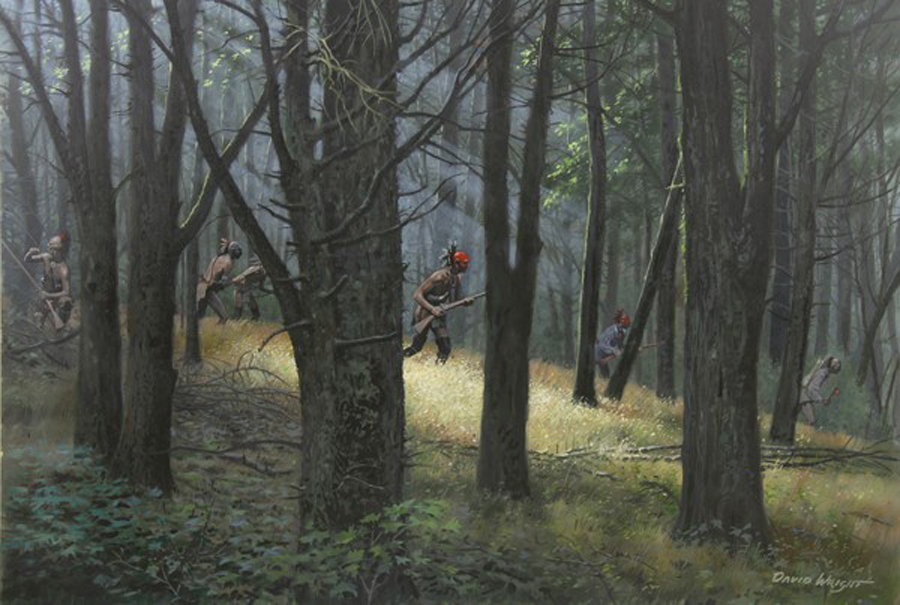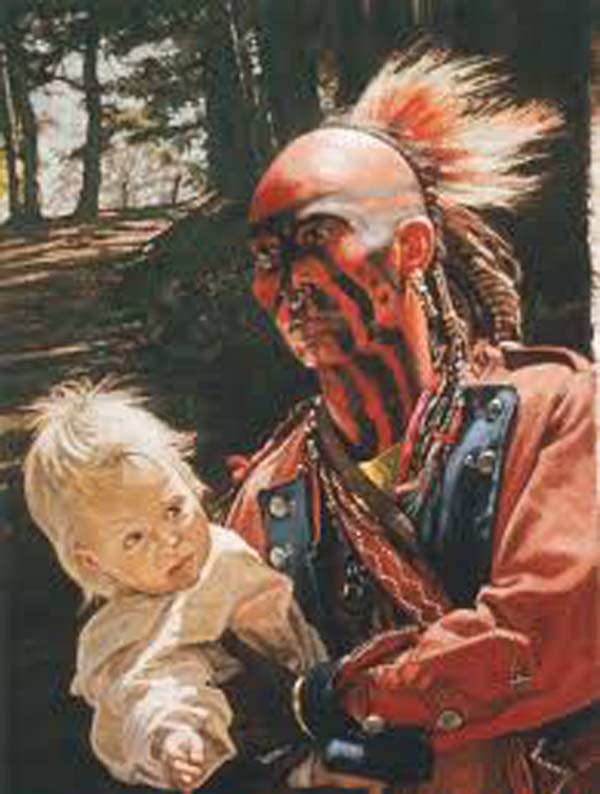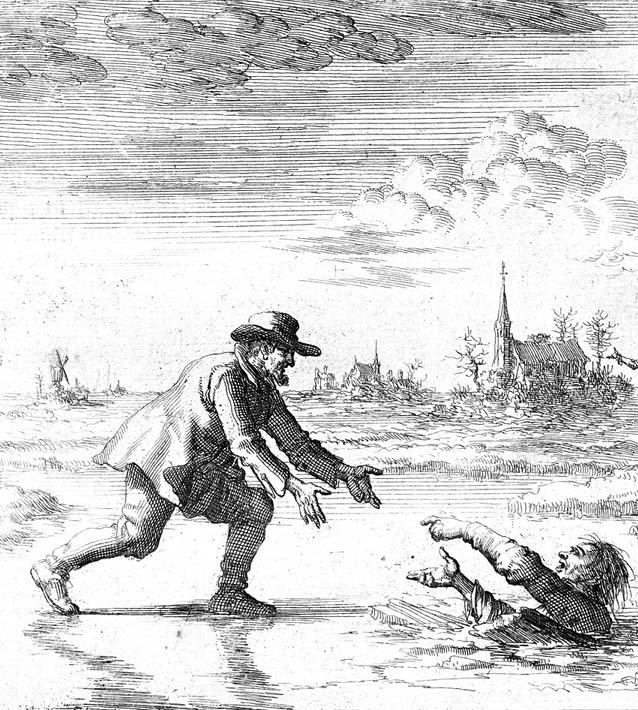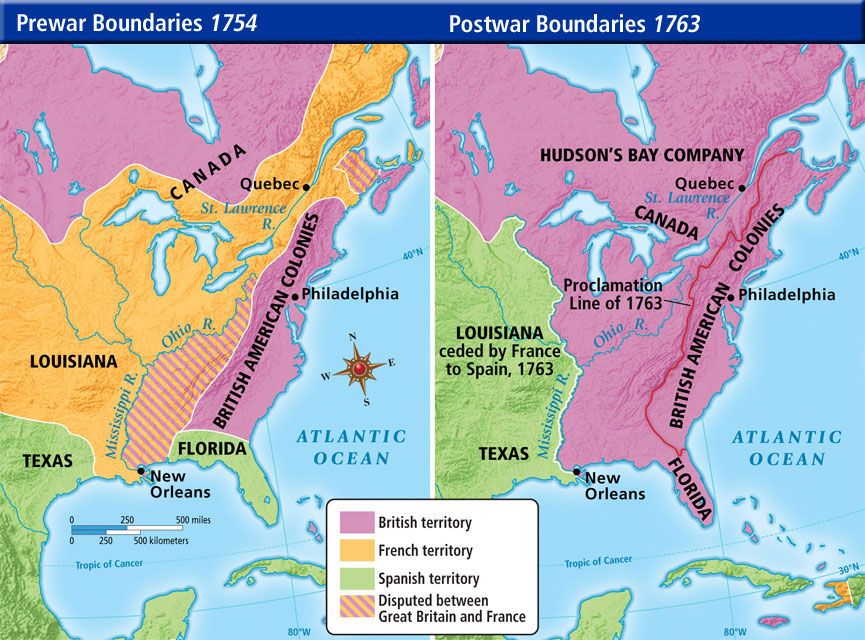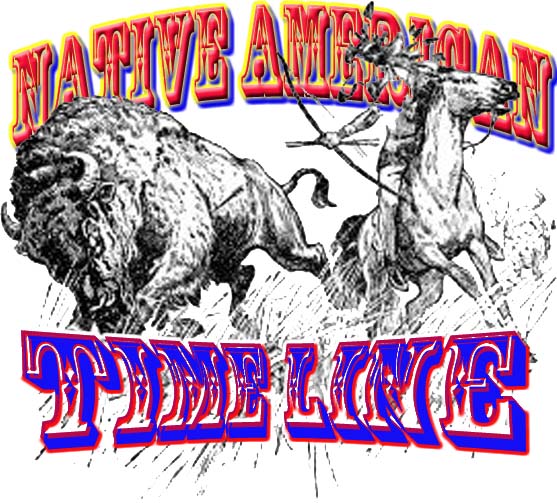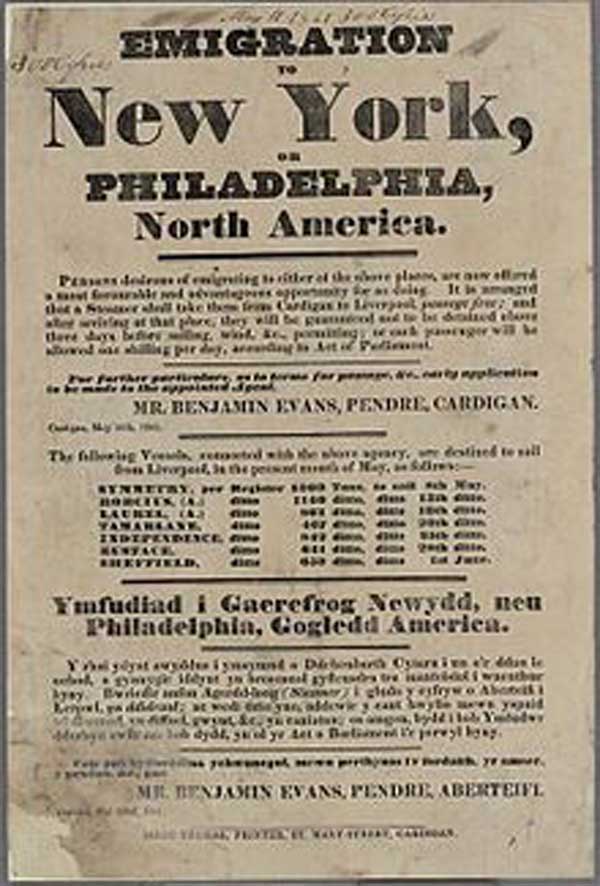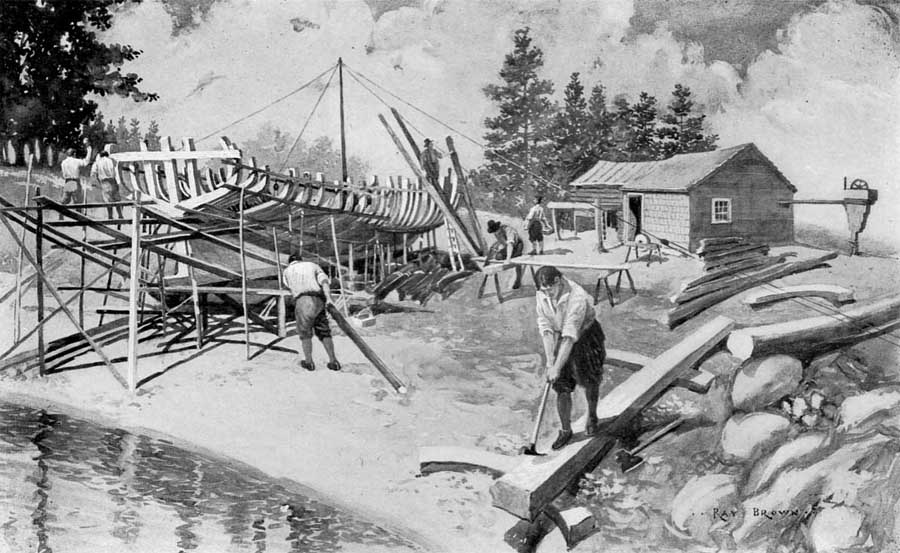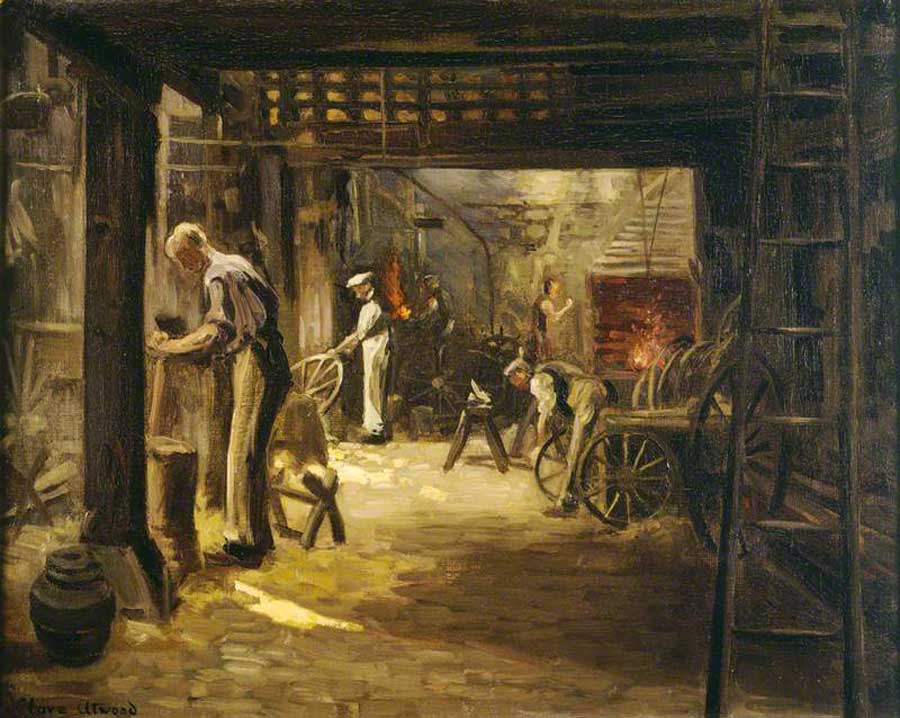Ludwig and Anna Knauss had several children together. Among them were two sons, Sabastian Heinrich Knauss, born in the old country, and his brother Daniel Knauss (1728 TO 1792, 7TH GREAT-UNCLE), born in 1726 in Montgomery, Pennsylvania, when Sebastian Heinrich was 12 years old.
Daniel Knauss was born here
Even though a few years separated them, these boys were very close. Later in life, when they got married, they lived side by side on some of their father Ludwig’s land and started their own family. All the children were inseparable between the two homes, and both houses celebrated the holidays together. Each summer, they held a family reunion, and other relatives of both sides of the family came to enjoy each other’s company and eat a great meal together.
A great meal together
At each family get-togethers, they all took part in the communion service before eating their meal. The glass communion cup that was given to Peter Lee Knauss by Elisabeth Luther had long since disappeared. Whether after generations, its value had faded or over time, it became chipped, and someone just threw it away. The cup from the Knauss family’s first, Lord’s Supper, was no longer with the family, but the communion service was.
From the time they were young boys, Sabastian and Daniel were always eager to break the bread and pass the cup while celebrating the Lord’s last supper. Ludwig taught his sons to love serving the Lord by how he lived his day-to-day life. None of these men were pure saints, but they were servants eager to serve the Lord. So many essential things were hard to come by that it was easy for both boys to count their personal blessings. Their families came first in all matters. The stories about Jesus were no longer told around a campfire with the local storyteller. But now, they were taught from the Bible next to the fireplace in their log cabin. The light from the fire brought to life the stories and huddled together; they kept warm.
Bible stories by the fireplace
Family values that bonded together with each member, young and old, were necessary just to survive in this new land. Native Americans that had lost their homeland to the new settlers were still an ever-present danger. And they could threaten families living alone at any time. Many children died very young or did not survive childbirth without modern medical care, and this was a high risk to the mothers. So, families stayed together internally, and groups of families bonded to form small communities that all depended upon each other.
The games children played – Colonial times
One day when Sebastian was at the trading post resupplying his needs, he heard the latest news. A young man had been found wandering alone and scared in the wilderness. He was believed to be the son of a family that had moved to the frontier settlement. The Indians massacred his parents, and he had been carried into captivity.
Indian raid
Having nearly lost his original language during the time he spent with the Indians; it was difficult to make himself understood. Still, he told his story the best he could. It was a story about a family that the toils of a lifetime were brought to ruin. In humiliation, his parents had turned their faces and steps toward the wilderness of the far west. They hoped to retrieve their fortune and a better feature.
captured by the Indians
The boy was only 7 years old when the Chief of the tribe adopted him, and he was treated very kindly. Unfortunately, the Chief lost his life in the Indian Wars, and his adopted mother became the wife of a second husband. This fierce Indian warrior treated the boy with much roughness and severity. This behaviour toward her son incensed his mother, who had always treated him with kindness. She was determined to retaliate against her new husband and prevent the white boy from receiving any more abuse. One time when her husband was off on a long hunt, she sent him to the white folks at the settlement. She assumed that his parents were still living, and he would be better off living with his own people.
Indian warrior on the hunt
The young man was now 14 years old, having lived in captivity for seven years. His adopted mother provided him with a small sack of pounded roasted corn and dried venison. She started him along the trail through the forest and told him to “travel three days in the direction of the sun, and then you will reach the home of the white men. There you will find your own father and mother.”
held captive by Indians
When he reached the settlement, he sought in vain for his parents. Only by persuasion was he prevented from returning to the Indians. He went homeless and resorted to the community for help and employment. A British vessel of War was in the harbor in need of recruits, so they came inland to get them, and the young man was seized again and forced by a press-gang into naval service. He was only 15 years old, but he served seven years with the hardships of a sailor’s life.
press gangs
During his seafaring time, he received from his shipmates the rudiments of a meagre education. He deserted the ship off the coast of New Jersey, and by the “Grace of God,” he discovered some of his kin. He had a very picturesque career. He and his family were the first white settlers, his romantic sojourn with the Indians, and being forced on a British man of war made him a very cold and unreachable young man. This was one of many stories going around the trading post about relationships with the Native Americans.
Indian attack
After another Indian massacre, a few old men, women and children about 50 in all, fled the forest for safety. A single sack of Indian meal constituted their only provisions. Nathaniel Parker was killed in the attack, and his wife lay in a hollow log with her baby. She watched while the Indians ran through the woods on their terrible mission.
fighting to the death
After several days of suffering and being pursued by the Indians, a portion of these helpless wanderers found their way to the nearest settlement. They were given food, water, and shelter, and a blind mare on which to carry the young children on their journey back east.
pursued by Indians
Sebastian Heinrich also heard about the Bradford family killings. On the morning of May 27, 1756, while Joshua Bradford was pounding corn, a party of Indians approached his cabin.
Bradford family birth records
He sounded the alarm with a shot fired from his rifle. But this was unheard by his family, and the savages entered the dwellings instantly killing, Mr. and Mrs. Bradford.
Indian massacre
Their daughter Maltiah age 14, fled with her infant sister Elisha toward the forest seeking a safe place to hide. An Indian threw a tomahawk at her inflecting a deep wound in her side, but she pressed on to safety. Two of her brothers were captured and sent to Canada. They remained there until Quebec was taken by General Wolf when they were freed and then returned to the Meduncook Bay Colony.
carried off by Indians to Canada
Moxus, a well-known Indian in Meduncook, was the leader of the raiding party that did the killing. Only a year previous, the old Indian was at Sebastian Heinrich’s farm. He traded furs for goods he could not produce like flour, cloth, molasses, and powder and shot. Not far from Sebastian Heinrich’s cabin, the old Indian was on his way home when he broke through the ice while trying to cross a frozen creek. He was within shouting distance, and Sebastian Heinrich heard his call and came running to his rescue. He bent over a young poplar sapling tree and pointed directly at the drowning victim. Moxus grabbed the treetop with such vigour that it broke off, but he was able to grab at it again and hold on.
Indian trading furs for European goods
Sebastian Heinrich kept shouting to him, “I am here, I am here, come to me, come to me, you can make it.” He could see that Moxus was struggling to hold on with the cold half-frozen stream water pulling him down with the current. He bravely stepped onto the ice to show Moxus that he was not afraid and would risk his life to save him. But still, the brave warrior was yet panicking, so Sebastian Heinrich said a quick prayer, then stepped out into the rushing water almost up to his neck and grab hold of Moxus.
rescue from the frozen water
When he finally got the half-drowned Indian to the bank of the creek and safety, he told Sebastian Heinrich a promise. The half drowned Indian told him, “You are my great white brother. Through all times, I will always be in debt to you for saving Moxus’s life.” The scoundrel professed much gratitude, and he and other Indians pretended much friendship. The tribe placed a large stone where Moxus fell through the ice. After that, each time a member of the tribe passed that spot, they put a small rock on the bigger one. This was done as a reminder of the rescue of their Chief that day. Sebastian Heinrich had a lingering cough that lasted for years as a personal reminder of his selflessness.
a helping hand
Now Sebastian Heinrich said to himself, “all times must have run out, and that Indian Moxus had a very short memory.” At this time, knowing the Indians were in the neighborhood, most of the people fled for safety to the fort. Still, the Knauss family was very confident that no harm could be done to them, and they chose to remain at their farm.
Indian alert
These stories were true, and they were about real people, not just made up. Some of these people were known to the community that Sebastian Heinrich and his family lived with. He had a friendly relationship with his Indian neighbors. There was a coal mine on his farm, and he shared it with the Indians and taught them how to use it. Many times, he went hunting and fishing with them. They always helped during harvest time, and they all shared in the bounty. The Indians brought fresh game like wild turkey, plenty of venison meat, and then they ate a meal together.
a meal with the Indians
Ludwig Knauss, Sebastian Heinrich’s father, had been driven out of his native homeland by invaders from other countries. They persecuted them because they followed the teachings of Martin Luther. Germany was so chaotic that, for many, their only hope lay in work and prayer. These pietistic religious sects were very appealing because of the salvation they offered.
wars over religion
Whether they did it unknowingly or did not want to face the fact, now they were doing the same thing to the Native Americans in their homeland. And consequently, the colonies found themselves at war with the Indians. Native Americans joined forces with the French, and battles were waged on Pennsylvania’s western frontier during the French and Indian War.
French and Indians war
The Germans brought with them to America a rich religious tradition. Many Germans were farmers and led simple lives. They valued hard work and piety, and created sects named after honoured leaders. The Schwenkfelders took their name from Caspar Schwenkfelder. The Mennonites took their name from Menno Simmons. The Amish took their name from Josh Amman. The Herrites were named after Christian Herr. After Martin Luther challenged the Catholic Church in 1517, the movement he started gained a large number of German supporters, particularly those who were financially repressed.
Luther preaches using his Bible translation
Germans flocked to Pennsylvania to escape warfare. The Thirty Years War had ravaged Europe, and for many Germans, the only way to avoid it was to flee to the Colonies. Before European settlement, Pennsylvania was inhabited by many native tribes, including the Erie, Honniasont, Huron, Iroquois (especially Seneca and Oneida), Leni Lenape, Munsee, Shawnee, Susquehannock, and unknown others.
Native Americans Tribes & Peoples – part 2
Thousands of Germans settled in Pennsylvania, making up one-third of the population. They mostly settled in the interior counties of Northampton, Berks, Lancaster, and Lehigh. These immigrants brought with them a strong farming background, and they helped convert the wilderness into a prosperous farming community
Moravian settlement at Bethlehem Pennsylvania
The Knauss family, along with many other families, were drawn to Pennsylvania for farming, industry, trading, and learning that were all characteristics of the colonies started by William Penn. King Charles II of England owed $80,000 to Admiral Sir William Penn. The king paid off the debt by granting his son, also named William, the territory of Pennsylvania and calling it in honour of his father, the admiral.
Willian Penn receiving Pennsylvania’s royal charter from King Charles II of England
Penn made a treaty with the Leni Lenape to purchase his grant of land from them, even though there was no law requiring him to do so. The treaty’s duration was for “as long as water flows, and the sun shines, and grass grows.” Penn and Taminend, Leni Lenape chief, exchanged wampum belts under the Shackamaxon elm tree in Philadelphia.
William Penn signing a treaty with the Leni Lenape Indians
Penn encouraged immigration to his colony by offering, “30 shillings per hundred acres, and shares of 5,000 acres for 100 pounds.” Countless Europeans were persuaded by these lavish terms to migrate to America.
He printed flyers advertising his colony in the English, German, and Dutch languages. Ludwig Knauss, along with many other Mennonites, immediately responded by migrating to America. Their agent, Francis Pastorius, went to Pennsylvania and founded Germantown, a colony for the German immigrants. Bringing Germans to America soon became a profitable business, and after 1717 Germans were brought to Pennsylvania in masses. They created a rich farming culture as well as a diverse religious culture.
flyer promoting migration Pennsylvania
The Native American homeland was transformed into very prosperous farmland during the colonial period. Wheat and corn were the most abundant. Rye, hemp, and flax were also grown where the Indians had lived for centuries free from European invaders.
colonial farming
Industries like sawmills and gristmill sprang up along the numerous streams taking advantage of the many natural resources that Pennsylvania’s Indian population relied on for survival. These streams were now the lifeline of trade, providing quick access to the inland, and they were critical to the shipbuilding industry that flourished along the coast.
shipbuilding
Philadelphia was founded in1682, having a high and dry land next to the water with a shore ornamented with a beautiful view of pine trees growing upon it. The city became the most important center for foreign trade in the colonies by the time of the Revolutionary War.
William Penn landing at Philadelphia
The College of Philadelphia became a non-denominational learning centre. It was the only one of its kind during the colonial period giving rise to such intellectuals as Benjamin Franklin, John Rittenhouse, John Bartram, and Benjamin West. The first hospital, library, and insurance company started in Pennsylvania.
Academy and College of Philadelphia
The new settlers cut down the trees and built roads. They followed the paths through the wilderness first started by the wild game, then become the main freeway for the Native Americans. Sebastian Heinrich had walked these trails many times with his father, and as a young man, he learned to appreciate how the native people lived and traveled.
a man falling a tree
Pennsylvania’s trees made it possible for the papermaking industry to become an essential part of the colonies’ economy. The availability of iron ore started the iron production industry, which supplied the gun manufactures. In Lancaster, county gun makers invented the Pennsylvania Long Rifle, which became very popular with the colonists and the military.
Pennsylvania Long Rifle
Ludwig Knauss was a deacon of the Reformed congregation during the ministry of the Rev. John Philip Boehm. He often shared his views with many, “the congregation of God in the Spirit is found in the sons of Ludwig Knauss, Sebastian and his brother Daniel.”
Sebastian Heinrich, as a young man, like his father, served his apprenticeship in the home of the prominent Reformed Elder Henry Antes. He was a farmer, and he taught his trade of wheelwright to Sebastian Heinrich. While Sebastian Heinrich was learning his trade in the employment of Brother Antes, he also benefited so much spiritually, listing to the pious Elder’s lessons from the Bible. He was inspired to meditate deeply about the conditions of his soul. Fearing that all was not well, he began to meditate, and his thoughts were filled with restlessness and anguish.
Wheelwright’s Shop
He prayed, “O’ heavenly Father, please lay thy hand on your servant and direct my path. Protect me from evil, temptations, and greed. And keep me humble, and may you always find me ready to serve.” Sebastian Heinrich had the good fortune and the joy of serving the newly started work of the Lord in his neighborhood as a good steward. He approached every challenge energetically in every possible way, and his cheerfulness and readiness to get right to work were an inspiration to others.
praying for guidance
In 1741 Sebastian Heinrich married Anna Catharina Trenseau, and they settled on the first farm on the south bank of the Lehigh River in Maguntsche. He and his wife repeatedly walked to Bethlehem over an Indian path and visited with the Brethren there. From that time on, the work of the Holy Spirit went on within his heart. They both were dedicated members there even before the Maguntsche congregation was established. Sebastian Heinrich was elected as a warden of the Church, and Anna Catharina served as a stewardess.
Lehigh river
In twelve years, Sebastian Heinrich and Anna had ten children together. They were of small stature, exceedingly bright, and the girls were beautiful of form. The descendants of these children became so numerous that it is impossible to follow them all. It is enough to say that in every township and borough in the county, the name Knauss is found, and in most cases, the line of descent can be traced to this branch of the family.
Sebastian Heinrich was 40, and Anna was 33 years old when she gave birth to a son on March 11, 1775. This was a time when Americans were caught up in the turmoil of the French and Indian War. The parents named him after the Hebrew patriarch, Abraham Knauss (1754 to 1836, 5th great-grandfather).
Abraham Knauss was born here
The proud father looked at the newborn as he held him for the first time, and he prayed, “Our precious Heavenly Father, we thank you for the health of this child and his mother. We hope to honour your people by giving him the name of Abraham and ask you to bless him. And please, Father, always draw him close to you and direct his path.”
soldiers of the French and Indians war
When Sebastian Heinrich and his brother Danial came to this country in 1723 and settled at Emaus, they were not wealthy. Still, through their honest and industrious efforts, they acquired much land from the Penn family estate, and they were among the foremost residents in their time.
Emaus Pennsylvania
So that the children might be trained in the knowledge and love of God, a schoolhouse was erected in 1746. Sebastian Heinrich and his neighbour Jacob Ehrenhard were elected and ordained stewards of the newly organized Moravian Church at Emus. This event was closed with the celebration of communion of the Lord’s Supper. For uniformity sake, it was agreed that the sacraments should be administered according to the Lutheran custom and regularly break the bread of life to the hungering souls. Thirty-two new members were welcomed into the Church that day.
The Knauss and Ehrenhard farms were only separated by a stream that ran between the two. The two men together donated over 100 acres of land for the creation of a hamlet, including a school, church, and the adjacent grounds.
Before the close of the year, a small log church was completed. It stood within the old burial grounds. The basement of this first building was used for school purposes. The second story as a parsonage. While the annex was the entrance to the Church using the steps. Sebastian Heinrich Knauss is therefore known as the founder of Emaus.
Moravian Church at Emu
Sebastian Heinrich was very thrifty with a good sense of business and a master of numbers. He was small of stature, had auburn hair, he was a good conversationalist, good-natured, and all who worked with him just loved him. He was always passing out to them, fresh bread from the kitchen with honey on it from own his bees.
Bees and beekeeping
He took full advantage of the natural resources that were on his land. He sold the coal from his mine to the local iron producers and helped keep his county warm in the winter. He was a weaver of fine linen. And now he was teaching other young apprentices the trade of wheelwright, and they worked in his shop. But farming was always his most rewarding and satisfying chores of each day.
early map of Pennsylvania 1756
Through his thrift and self-motivation, he acquired several tracts of land. Some were still unsettled wilderness full of trees and wild game. Other sections were cleared farmland that had been left abandoned by the failed attempts of others to settle there. In all, he was the steward of over 400 acres of some of the best lands in Pennsylvanian, and he donated 45 acres of cleared land toward the future site of Emmaus. He gave liberally of his time and freely gave of his means and land toward this object. The ground, including the park where the reunion was held, belonged to the family. In 1763 Sebastian Heinrich moved his family from the log cabin on his farm to Lots 31 and 32 and built them a stone house on the northwest corner of Main St. and Keystone Avenue.
Seven generations of the Knauss family lived in the homestead
All too often throughout history, life has been cut short by the actions of one’s own deeds. We never know how what we do today will affect our life of tomorrow. Saving someone’s life may cost your own.
The cough he caught while trying to save Moxus and had plagued Sebastian Heinrich for so many years was catching up with him. He always felt worse each fall in the cold, and during the damp weather in the spring, but he seemed better during the summer months. This year was different. The cough only got worse, and this time it did not get any better during the warmer summer days.
The Dr. that came to see him was in tears when he told him he was dying from a cold, which had developed into inflammation of the chest consumption (pneumonia). Sebastian Heinrich clearly recognized it as the will of the Lord, and he soon would be in His presence. Thereupon he wisely set his house in order, commended his wife for her everlasting devotion to the Lord. He blessed his children in a genuinely patriarchal manner by serving them the communion meal one last time. Having done all this, Sebastian Heinrich wrote his last will and testament.
advice from the Doctor
I, Sebastian Knauss of Salisbury Township, in the village of Emmaus, in the county of Northampton, in the province of Pennsylvania, wheelwright.
being sick and weak in body but of sound memory and understanding for which I thank my dear saviour, the 24th day of February 1777, make and publish this, my last will and testament. How and in what manner after my decease it shall be acted with my real and personal estate. Also in the manner following first, so:—
The plantation containing about two hundred acres, but it shall be for grain and hay only which my beloved wife, Anna Catherine, shall have for the maintenance of her and the children that will be with her.
Further shall my wife, Anna Catherine, have the use of the orchard during her natural lifetime upon the land which I bought from Earnhardt land on the hill.
After her decease, it shall be divided in equal parts or shares amongst my thirteen children or their heirs as also the money from the land shall be divided amongst aforesaid thirteen children.
Further, so shall my wife have liberty to keep for her own use during her natural lifetime anything and so much as she will from my personal estate.
Sebastian Heinrich’s will was written in German by his own hand and later translated to English by Lewis Klotz so the local magistrate could oversee the handling of the estate. The will was presented and read January 29, 1782, before Judge John Arndt in Northampton County and was witnessed by his sons Abraham and Henry Knauss.
a colonial judge
Sebastian Heinrich was sickly but of sound mind at the time of the writing of his will on February 24, 1777. His son Abraham was already living at the 200-acre plantation on the land bought from Jacob Enernhard on a high hill with a peach orchard. For the next seven years, he paid rent to his mother so she could support the rest of the children still living at home. Then the estate was sold and divided up among all the children.
Shortly after that, in 1777, at the age of 62, Sebastian Heinrich Knauss died in Emmaus, Pennsylvania, and he was buried there. Jacob Ehrenhard, along with many friends and family members, was at his side when he passed. He spoke for everyone in the room when he said, “In this state of heart and mind, he did his duty as steward with faithfulness and punctuality through all these years until his Creator’s hand relieved him from further duty.”
Sebastian Heinrich Knauss 1714 – 1777
After a long pause he broke the silence again, “As far as a eulogy is concerned, it is best to leave that to Him who said: “Well done, good and faithful servant.” Our departed brother never desired to seem anything else before God, angels, and men, then just a sinner, to whom had been given the grace of God through the sacrifice of Jesus.” Tears interrupted him for only a moment, later he said very softly, “His memory shall be blessed.”
Trying to support and encourage the family, Jacob went on to say, “We must admit that his departure is our sad loss. His dear wife has lost a loving husband, his children a true and exemplary father, and the local congregation a friend and neighbor ever ready to help.”
After leaving the family, Jacob told the rest of his community, “Under these circumstances, our Brother Knauss finished the course of his life, February 26, 1777, aged 62 years, 5 months, and 3 weeks. ‘Blessed are the dead which die in the Lord, for they rest from their labors.'” Sebastian Heinrich was blessed with a faithful wife and from this happy wedlock, thirteen children, eight sons, and five daughters, and twenty grandchildren.
Sebastian Heinrich Knauss coat of arms
Timeline 1770 – 1789
Abraham was a blessing to his parents, and he grew up to be a man of good character and great physical strength. He followed the trade of blacksmith, and every family in the community knew him by name. After his father Sebastian Heinrich passed away in 1777 at the age of 62, throughout the years, Abraham kept everyone’s horses shoed and their wagons rolling as a smithy and wheelwright. He had learned these trades from his father.
colonial blacksmith
In 1780 when Abraham was 26, he married Elizabeth Boeckel, and they started their life together close to her family in Upper Milford Township. They had only one child together, born in 1784, and they named him Lewis Ludwig Knauss. Abraham’s business prospered, and like his father Sebastian Heinrich before him, he also saw investing in the land was a wise decision. His first purchase was five acres recorded in the Hanover Township, Northampton county taxes in 1785. In 1798 he bought a farm in Allen, and he settled there with his family.
Hanover Township, Northampton
Abraham took the oath of allegiance to the Commonwealth of Pennsylvania in1786 before Judge Peter Rhoads. He further showed his patriotic spirit by enlisting as a member of the Fourth Battalion, Northampton County Militia, a civilian reserve designed to repel any invasion of Pennsylvania by the British. He served as a private 5th class in the 7th Company under the command of Captain Felix Good in 1782.
colonial Militia
Paul Revere created an effective propaganda piece that lent credence to those demanding that the British authoritarian rule be stopped. On March 5, 1770, a multitude of patriotic Americans approached British troops, and they opened fire on the crowd killing several. The British call it an “Incident on King Street.” The Boston Massacre sparked fury in both Americans and the British by portraying the redcoats as brutal slaughterers and the onlookers as helpless victims.
Boston Massacre by Paul Revere
The Pennsylvania Militia required compulsory enrolment of all able-bodied white males between the ages of 18 and 53 to repel invaders. American soldiers came from a variety of backgrounds, and they had numerous reasons for fighting with the American army. Abraham was recruited into the Rangers, a special battalion of soldiers who served long periods of enlistment to protect the frontier against Indian incursions. This allowed him to spend much of his time guarding his own farm. The constant threat of war between the English and the Cherokee weighed heavily on Abraham.
battling Indians on the frontier
In the fall of 1821, during butchering time, his wife Elizabeth was severely burned. She was scalding chickens in boiling water to remove the feathers when the large pot overturned. She was unable to get out of the way of the spilling hot water, and she was severely injured. Abraham was devastated as he tried to help her, but she died from the burns shortly after that. His faith held him up, and he told his children, “the light of my life is now in the presence of the Lord, and she is there now shining brightly.” He was like a solid rock that his children could cling to, and he held the family strong together.
scalding chickens to remove the feathers
Abraham was a Democrat, and he took great interest in his party. In 1823 he was a member of the Democratic Vigilance Committee, and he was the tax collector for Hanover Township. He died in 1836 in Hanover, Pennsylvania, having lived a long life of 82 years.
When Lewis Ludwig Knauss (1784 to 1836, 4th great-grandfather) was born in 1784, his father Abraham was 30, and his mother Elizabeth was 25 years old. The family lived in Upper Milford, Pennsylvania. When he was 18, his parents moved to Hanover Township, where he met and later married Sarah Minnich. After saving all they could in their first year of marriage, they were able to purchase a 55-acre farm in the Saucon Valley, Northampton County, Pennsylvania.
Lewis Ludwig Knauss place of birth 1784
Lewis and Sarah Knauss were living in Upper Milford, Pennsylvania, when it became the second state in the Union.

Pennsylvania became the 2nd state and 1st commonwealth to join the Union in 1787
In 1813, in a little one-story double log house, their son Edward Knauss (1813 to 1894, 3rd great grandfather) first saw the light of day. Ludwig was 29, and Sarah was 23 years old. He was the only child they had together.
Edward Knauss was born here 1813
At about this same time, John Chapman, better known as Johnny Appleseed, was roaming the countryside planting apple nurseries. He was an American pioneer nurseryman who introduced apple trees to large parts of Pennsylvania, Ontario, Ohio, Indiana, and Illinois.

Johnny Appleseed
Sarah was always plagued with poor health, and she passed away on November 14, 1834, at the age of 44. Edward worked the family farm with his father Lewis until his death just six months to the day after his wife Sara had passed. At the time of his death, his estate consisted of three horses, two colts, seven cattle, nine sheep, five hogs, and eleven geese, which were all left to his only child Edward Knauss. In 1840 Edward married Catherine Ruch, and they had only one child during their marriage. When Amos Knauss (1859 to 1917, 2nd great-grandfather) was born in 1859, his father Edward was 46, and his mother Catherine was 39.
Amos Knauss place of birth 1859
Edward was a cooper and a farmer and resided at the family farm. The coopers made wooden barrels large and small. All sizes of little casks were required to ship products like salt, flour, salt-packed meet, and to safely move gunpowder. The shipping industry used larger barrels called “hogsheads” to send more significant amounts of tobacco and other products from the colonies to Europe.

Coopers at work
Sometime later, he moved to Forks Township, but he only remained there for a short time. In 1868 he purchased about 50 acres of land in Lower Saucon Twp. From his father-in-law’s estate on which he then relocated.
land ownership map
The ratification of the 15 Amendment of February 3, 1870, The 15th Amendment was ratified on February 3, 1870. It prohibited the federal government and each state from denying a citizen the right to vote based on “race, color, or previous condition of servitude.”
Edward Knauss personally witnessed and experienced some political discrimination while living in Lower Saucon. He told his family, “It saddens my heart to see men struggle with freedom.”

passage of the 15th Amendment
The log cabin where Edward was born was the family home for generations. And 30 years later, his cousin David Knauss (1843 to 1920, 3rd cousin 5 times removed), was also born there. They both had the same great, great, Grandfather Johann Ludwig Knauss.
David Knauss place of birth
David could trace his family tree back to his father, Levi Knauss (1813 to 1895, 2nd cousin 6 times removed), in Lehigh, Pennsylvania, and later moved to Three Rivers, Michigan.
Levi Knauss
Levi Knauss was born here
He made his occupation as a saddler, harness maker and farmer of a fruit orchard. Levi was a member of the Reformed Church, and he was a lifelong Democrat. He died in 1895 at Three Rivers, having lived a full and long life of 81 years.
David’s grandfather Jonathan Knauss (1757 to 1843, 1st cousin 7 times removed) was born in Weisenberg, Pennsylvania. He took part in the protest of the Stamp Act in 1765 when the people took to the streets to show their opposition to the British rule of the colonies.
Jonathan Knauss was born here
The British Parliament passed a tax on every piece of printed paper used by the American colonists. All legal documents, licenses, newspapers, and even playing cards were subject to this new tax. He died in 1843, in Northampton, Pennsylvania, having lived a long life of 85 years, and was buried there.
Jonathan Knauss tombstone
 Timeline 1790 – 1799
Timeline 1790 – 1799
David’s great grandfather Daniel Knauss was born in Montgomery, Pennsylvania. He served as a private in Capt. Joseph Siegfried’s 8th Co. 3rd Battalion Northampton Co Militia in 1778. He was one of the early settlers of Weisenberg Township, Northampton, and was a prominent man of affairs. He was one of the signers to petition the court to establish Weisenberg Township, and he was elected committeeman in 1775 by the freeholders of his county. His occupation was a sickle-maker and a farmer and owned 650 acres of land. He also operated a grist mill in 1785. He died in 1792 in Whitehall, Pennsylvania, at the age of 66.
Timeline 1800 – 1842
David could trace his family tree back to his great, great grandfather Johann Ludwig Knauss the first settler in the new world. He was the father of both Daniel Knauss, David’s great grandfather, and Sebastian Heinrich Knauss, the great grandfather of Edward Knauss.
Levi Knauss, David’s father, kept a record of the family tree in the family bible. David’s earliest memories are of his father telling him the stories that went along with the names that were written there. The book was old, and it had been passed along from father to son. Each generation was expected to pass on the history of their family to the next.
The history of photography
Next: The diary and memories of a Civil War soldier – part 1
>>Click here<<<
